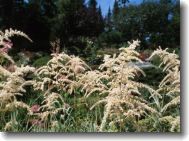 |
| Family | | | Food | | | Garden | | | House & Home | | | Money |
| Articles | | | Coloring | | | Cookbooks | | | Reviews | | | Newsletter |
 |
| Family | | | Food | | | Garden | | | House & Home | | | Money |
| Articles | | | Coloring | | | Cookbooks | | | Reviews | | | Newsletter |
Fall Perennial Careby Dr. Leonard Perry |
 |
Free Newsletter! Related Articles:Garden
| |
|
|||
|
1. Make "action" notes. Before you forget what plants should be divided, what should be moved and where, and what you need to do to certain plants next year, write it down now. 2. Should perennials be cut back now? It depends. If you normally get little snow, you may want to leave them until spring, so the stems can trap the snow. If you have perennials with attractive winter interest such as Sedum 'Autumn Joy' or ornamental grasses, you may wish to leave them for winter effect. Some seedheads, such as Black-eyed Susan, may provide food for birds. On the other hand, if you have rodents such as mice you may want to cut back ornamental grasses as they provide a winter home. Or if your perennials are diseased, you may wish to cut them back and destroy--don't compost--the diseased stems and leaves. Often gardeners in cold climates with short seasons have more time for cutting back in the fall than spring. When cutting back, leave a couple of inches of stems to help trap the snow. 3. Roses. Many gardeners have questions on overwintering these, and for more detailed information should consult other articles, books, and their garden centers on this subject. Some tips include making sure grafted roses have the graft union below ground a couple of inches or are covered with soil; mulch only with soil or Styrofoam cones if you have rodents, not with straw; and cut back only to top of mulch. Or plant some of the many hardy shrub roses. There are both new and old varieties on the market that require little or no protection. 4. Cover or mulch. This depends in part on your philosophy. Mine is that perennials should be able to survive with their summer mulch--a couple inches of bark mulch, shredded leaves, or similar material--or else placed in a warmer microclimate site, put in pots to winter indoors, or just not grown. Other gardeners don't feel this way, or have special perennials, in which case the rule would be to add more winter mulch. A foot or more of loose organic material such as straw can be used. Don't use hay as it often contains weed seeds. And don't use such mulch if you have rodents, as this only provides them with a home with your perennials as their winter food supply. Apply mulches late, around mid-November in the North, as perennials need some cold to harden properly. Remove mulches as early as possible or when snow melts. In the North, this should be done at least by April 1 and during a period of several warm days. Leaving mulch on too long will lead to tender and weak growth as perennials grow under the mulch. If you don't mulch your perennials during the growing season, you may want to provide a light layer of a couple inches of mulch for winter protection as mentioned above. This will provide 5 to 10 degrees of temperature protection to the soil in fall and spring, which may mean life or death for certain perennials at a time when they are least hardy. And even a light layer of mulch helps prevent wide temperature fluctuations with freezing and thawing, which breaks roots. Such organic mulches, of course, will break down, adding vital organic matter to the soil, and help conserve moisture and reduce weeds during the growing season. 5. Make new beds. If you want new perennial beds by spring, fall is a good time to start. If in hay, cut back low now. For sodded areas, strip of sod with a rented sod cutter. Or you can use a herbicide to kill the grass. Or you can just cover with black plastic, and most of the grass will be dead and composted by spring, and fairly easy to plant. Test soil and add lime now if needed. Other items on my fall checklist include checking and labeling plants as needed, putting out traps for rodents, digging tender summer bulbs, checking fall fertility and adding compost, and making cages for next year's tall perennials. Dr. Leonard Perry is an Extension Professor at the University of Vermont whose expertise is regularly featured in television and radio programming, as well as newspaper articles. Dr. Perry's latest research on perennials and hops is showcased on his website, Perry's Perennial Pages.
send feedback to: feedback@sherriallen.com. |
|||


|
home
|
family
|
food
|
garden
|
house & home
|
money
|
article archive
|
reviews
|
coloring pages
|
contact us
|
terms and conditions . privacy policy |
copyright © 2003 - 2006 by Sherri Allen all rights reserved |